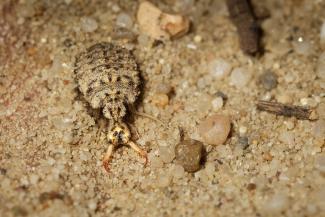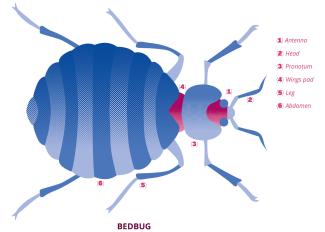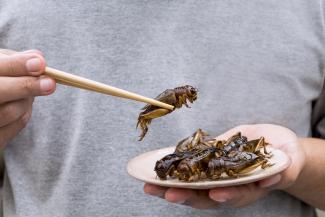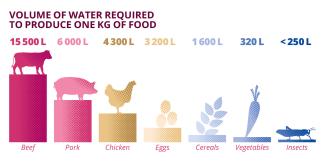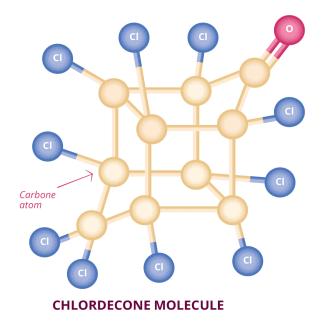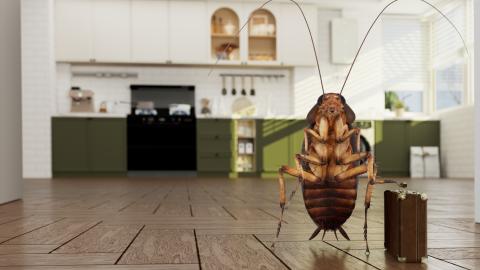
Living with insects: perspectives
(This article was originally published in L'Édition N.23)
Intriguing and delicious for some, pests to others, insects are a multi-faceted subject of study. Researchers from Université Paris-Saclay reveal their different approaches to this theme.
With over a million species already identified and around 10,000 new species catalogued every year, insects are one of the most complex and diverse groups in the animal kingdom. However, many mysteries still linger within this significant group, making it a fantastic field for transdisciplinary study.
Tracing the evolutionary line of antlions
Historical biogeography is the discipline that studies the distribution of species and their evolution over time. Bruno Le Ru, a researcher at the Evolution, Genomes, Behaviour and Ecology Laboratory (EGCE - Univ. Paris-Saclay, French National Centre for Scientific Research CNRS, Research Institute for Development IRD) has dedicated his latest biogeographical study to the antlion family (Myrmeleontidae), and more specifically to the Palparini and Palparidiini clades. Indeed, the evolutionary history of these insects, known for their large wings and remarkable colours, is still unclear today. No consensual classification of this group has yet been established, despite various studies already published on this subject.
Using dating analyses and a phylogenetic study of the largest sample of antlions tested to date, Bruno Le Ru and his team have proposed a new dated phylogenetic tree for the Palparini and Palparidiini clades, as well as a new common ancestor for both groups, which is thought to have appeared 92 million years ago, during the Cretaceous period. These new data have subsequently been used as a reference for more detailed molecular dating analyses and historical biogeography. The aim was to try and understand the evolutionary history and population movements of the two clades over time.
According to the study, the results "provide strong support for an origin of antlions in southern Africa," explains Bruno Le Ru. This origin is estimated at 108 million years ago. Moreover, these results suggest that multiple dispersions northward would have occurred from this region, with outflows from South Africa starting 75 million years ago. Today, the group is distributed only in the western part of the eastern hemisphere, with varied climates and vegetation, and about half the known species are endemic to southern Africa.
The researchers have therefore made a significant advance in our understanding of the relationships between these two subfamilies of antlions. The study is particularly interesting given the paucity of research on the origin and diversification of Afrotropical insects. However, Bruno Le Ru and his team stress the importance of further deepening these analyses, in order to "re-evaluate the entire tree and gradually redistribute each species" to its place closest to historical reality.
Bedbugs: an underestimated burden
Some insects, more familiar to Westerners, also attract the interest of the scientific community. This is particularly true for bedbugs, hematophagous parasites - which feed on human blood - that have been on the rise in France for about a decade. Although, based on current scientific knowledge, the insect is not a vector for pathogens, its bites coupled with its persistence in households make it a major public health issue.
Laurent Dalmas, a lecturer in economics at the Sustainability and Resilience Joint Research Unit (UMI SOURCE - Univ. Paris-Saclay, Université Versailles -St- Quentin UVSQ, IRD), has been looking at the cost of the burden represented by the proliferation of bedbugs in France. As a member of a working group assessing the impact of this phenomenon, he was one of the authors of a report published in July 2023 by the French Agency for Food, Environmental and Occupational Health & Safety (ANSES) on the impact, prevention and control of bedbugs.
Through interviews with the various sectors concerned (social landlords, hotels, collective housing, representatives of various French regional university and school centres (Centres régionaux des oeuvres universitaires et scolaires CROUS, etc.) and a survey of the general population, for the first time, the report gives an evaluation of costs based on both expenditure related to pest control and those linked to the impact on the health and well-being of individuals affected by these infestations, including medicines and consultations. "Our figures are always extrapolated, as individual data in economics are very hard to obtain," explains the researcher. "But the methods are thorough and our estimates are probably pretty close to reality."
The report estimated the cost of combating bedbugs in France, between 2017 and 2022, at 230 million euros a year. More specifically, it would cost every household about 866 euros to get rid of bed bugs, including treatment of the accommodation, material losses and the cost of inconvenience (consultations, treatments, physical and psychological repercussions, etc.). "This cost is only increasing, as the proliferation continues," notes the lecturer. The cost of the health burden was estimated at around 83.5 million euros for 2019.
Regarding the origin of the spread, Laurent Dalmas is categorical: "Contrary to popular belief, no study shows a correlation between immigration and the development of bedbugs. However, considering the explosion of the phenomenon in hotels, a spread related to tourism seems much more likely." The development of private rental accommodation has also probably helped to amplify the phenomenon, as homeowners are less aware of the risk of spread through their property than professionals.
According to the report, living standards do not necessarily play a role in the probability of being infested by bed bugs (one in ten French people say they have been affected over the last ten years, across all socio-economic backgrounds), but the difference seems to lie in the risk of seeing this infestation persist over the long term. This is due to the sometimes very high cost of treatments and the need to call in professionals, often several times.
"Saying that the less affluent populations are the origin of the proliferation is very stigmatizing," says Laurent Dalmas. “But they are indirectly, in the sense that they don't have the means to treat an infestation properly. It's not a question of hygiene." To combat this "burden" as effectively as possible, ANSES has recommended providing financial assistance to the most disadvantaged populations, to prevent a permanent establishment of these insects and their spread from one dwelling to another.
With the Paris 2024 Olympic and Paralympic Games approaching, Laurent Dalmas hopes that the report will highlight the urgency of investing in long-term treatment: "The fight against bedbugs is a long-term effort. Any measures put in place for the arrival of the Olympic Games would be totally ineffective if they only last three or four months." On an individual level, the report recommends non-chemical treatments, both for one's own health and to prevent bedbugs from developing resistance to these treatments over the long term.
An essential future food resource?
Rather than seeing them as parasites to humans, Nathalie Guichard, a researcher at the Network, Innovation, Territories, Globalization laboratory (RITM - Univ. Paris-Saclay) views insects as true assets for the population. "Entomophagy, or the consumption of insects, is an alternative practice that brings many advantages and few disadvantages," explains the researcher. “It's an interesting way of eating, both for the well-being of the planet and that of the individual." The perception and development of this practice are currently central to the Crikee project, funded since 2019 by the French National Research Agency (ANR) and for which Nathalie Guichard leads the "Familiarisation" component.
In an initial study published in 2022, the scientists explored the perception of entomophagy among young children (aged five to twelve) in France, using drawings and short interviews. "The idea of this first study was to understand their relationship with insects, what they imagined an insect-based meal would look like," says the researcher. Further studies were subsequently carried out with children and teenagers, including the production of visuals for insect-based product packaging, and the organisation of cooking workshops using insects.
The results: despite a notable lack of familiarity with the practice, children seem to have fewer barriers than adults. While insect consumption suffers from a very negative image - and even encounters several grounds for rejection - among adults, the drawings and interviews analysed convey a more nuanced feeling among younger people. "This can be explained by the fact that children are less neophobic. They haven't yet developed very fixed eating habits, unlike adults," clarifies the researcher. Although children generally show a lack of familiarity, they are often willing to taste something once they have been introduced to the practice."
These results provide essential insights in the context of redefining dietary practices in France. Nathalie Guichard confirms: "We know we're going to have to reduce meat consumption. Indeed, the production of some meats is highly polluting and, what's more, not all meats have nutritional benefits." For the researcher, eating insects, which are rich in protein and require very little space, water or electricity to produce, is a plausible alternative.
Another challenge for the Crikee project team is now to raise awareness of the benefits of eating insects and make them desirable to consumers who are still reluctant. According to Nathalie Guichard, who has worked with children for nearly thirty years, raising awareness of the practice among children and teenagers could prove effective in bringing insects into the family food repertoire: "We've already seen this with waste sorting and computing; through a phenomenon of reverse socialisation, children can also teach their parents a lot."
What remains is to find ways of convincing the general public, beyond scientific arguments, perhaps using commercial methods. "According to our latest studies, packaging seems to influence the appeal of insect-based products," reveals Nathalie Guichard. "Marketing will have an important role to play in this." Two articles and a book chapter are currently being written, and should provide some clues as to how to address this new challenge.
A transdisciplinary subject of study
Due to their ubiquity and great diversity, insects are a research subject that spans multiple disciplines, often requiring researchers from very different fields to work together. Environmental economist Laurent Dalmas sees this as a real opportunity. "I didn't know anything about bedbugs at the start of the study; my research was more focused on ticks in forests. But I was very well received by researchers who have been working on bedbugs and chemical control for years. Everyone can argue their point of view with their own expertise, and that's very stimulating."
Nathalie Guichard confirms: "There are around thirty of us working on the Crikee project. The group is very active because it's a subject that fascinates us all." The team, most of whom are based in France, is already planning to continue the project together, which is currently scheduled to run until March 2024.
Multiplying perspectives, working together and breaking down the barriers of research all emerge as indirect consequences of studying insects. Between current problems and essential future resources, this subject of study looks set to be a vector for many future collaborations.
References:
- Noémie M.C. Hévin et al. Evolution, systematics and historical biogeography of Palparini and Palparidiini antlions (Neuroptera: Myrmeleontidae): Old origin and in situ diversification in Southern Africa. Systematic Entomology. 2023.
- https://www.anses.fr/fr/system/files/ANSES-RA2021-ProduitsBiocides.pdf
- J. Brée et al. Au menu : Écrasé de fourmis, sauterelles grillées, steaks de moustiques, chips de grillons… : Une approche par le dessin des représentations enfantines des insectes et de l’entomophagie. Carnets De La Consommation. 2022
Chlordecone degradation by methanization: a second chance for contaminated agricultural waste?
Used in the French West Indies between 1972 and 1993 to combat banana weevils, chlordecone is now one of the research topics of the scientists at Genoscope, the French National Sequencing Centre. Recent studies have demonstrated the effectiveness of methanization in degrading this insecticide, paving the way for the depollution of affected areas.
Could it be that chlordecone, a toxic insecticide renowned for its persistence in the environment, is not indestructible after all? This is one of the questions a group of researchers from Université Paris-Saclay and Université de Lorraine have been trying to answer for over thirteen years.
Pierre-Loïc Saaidi, a researcher at the Genoscope’s Genomics Metabolics laboratory (Univ. Paris-Saclay, Univ. Évry, CNRS, CEA), now leads the team responsible for studying chlordecone transformation products. Commissioned in 2010 to identify bacteria capable of degrading the insecticide, the scientists are now studying the chlordecone transformation products produced by methanization. This work is being carried out in partnership with Yves Le Roux's team from the Animal and Agroecosystems Laboratory at the University of Lorraine, specialising in the methanization of agricultural waste at the experimental methanization platform at the Bouzule farm, near Nancy.
A persistent insecticide
Used for over twenty years in the French West Indies to combat banana weevils, chlordecone now raises significant health and environmental concerns. Due to its cage-like structure and the presence of chlorine atoms (which protect the carbon chain from degradation), the molecule is now one of the twenty or so most persistent organic compounds known.
Its high affinity with organic matter, in which tropical soils are particularly rich, partly explains its persistence in the West Indian environment. Coupled with the insularity of the contaminated farmland, the pollutant is still present in large quantities in these territories today. It is estimated that a quarter of all usable agricultural land is contaminated, impacting the soil, water and the entire food chain - including humans - due to its strong bioconcentration effect.
Classified as a probable carcinogen by the International Agency for Research on Cancer (IARC) in 1979, chlordecone was detected in nine out of ten West Indians in the Kannari study (Public Health France, 2018), illustrating the consequences of this massive use. To avoid further widespread contamination related to food, a process has recently been introduced to decontaminate livestock intended for human consumption. This process generates large quantities of contaminated effluents, which are currently impossible to treat.
Methanizing contaminated agricultural waste
Both teams of scientists are particularly interested in the treatment of these contaminated livestock effluents. In a study published in August 2023, the impact of methanization on chlordecone was tested for the first time. This industrial process degrades and partially transforms biowaste (plant and animal) into biogas (methane, carbon dioxide, etc.) through the intervention of microorganisms.
By adding chlordecone to the content of a methanizer, the researchers have demonstrated chlordecone degradation under high-temperature conditions (55°C). "After 40 days, the amount of chlordecone had decreased by more than 80%," says Pierre-Loïc Saaidi. Several transformation products resulting from this degradation have already been identified. "And there are probably more, as the transformation products detected do not account for all the degraded chlordecone," adds the researcher.
Evaluating toxicity
While the process does not yet completely degrade chlordecone, the conclusions drawn from this proof of concept are encouraging: "We've reached the first stage, namely the transformation of chlordecone into several less chlorinated compounds," explains Pierre-Loïc Saaidi. "This study is a reference for us and will be a solid foundation for the future." Researchers are now attempting to methanize these transformation products directly, in order to determine whether they are end products or whether they can be further degraded into non-harmful products.
There is still a need to gain new insights into the multiple transformation products of chlordecone. "We have received funding to study their toxicity in particular," explains Pierre-Loïc Saaidi. "Currently, it's estimated that their toxicity is about the same order of magnitude as that of chlordecone, or slightly less." These findings are highly anticipated so as to gain a better understanding of the situation on the ground: a slight natural degradation of chlordecone has indeed been demonstrated in the West Indies, but the transformation products present in the soil have not yet been included in the toxicity evaluation of the land.
Towards greater energy independence?
The results pave the way for energy recovery not only from effluent, but also from other agricultural wastes contaminated with chlordecone. Methanization is thus positioning itself as a strategy of interest to the French West Indies, contributing to the clean-up of chlordecone and, through the production of biogas, the energy autonomy of these island territories that are still highly dependent on oil.
How long before this process can be tested in situ? "The timescales for this project are a few years," explains Pierre-Loïc Saaidi. "But since methanization technology is already available for large volumes, on-site deployment will be very quick once the steps have been validated analytically." A pilot methanizer was installed at the INRAE station in Petit- Bourg, Guadeloupe in July 2023.
This colossal challenge, while raising many questions for scientists, is also a source of hope for local populations. "When you're a researcher, it's not often that you get the chance to face a real problem and try to provide solutions to the population," adds Pierre-Loïc Saaidi. Originally specialising in organic chemistry, the researcher is quick to turn to other disciplines according to the project's needs. "Since the ultimate aim is to address the issue of chlordecone pollution, I don't mind," he concludes. "There's a very particular kind of injustice that makes this subject even more motivating for me."
Reference:
- D. Martin et al., Efficient biodegradation of the recalcitrant organochlorine pesticide chlordecone under methanogenic conditions, Science of the Total environment, 2023.
This article was originally published in L'Edition No. 23.
Find out more about the journal in digital version here.
Subscribe to the newsletter and never miss an issue.

